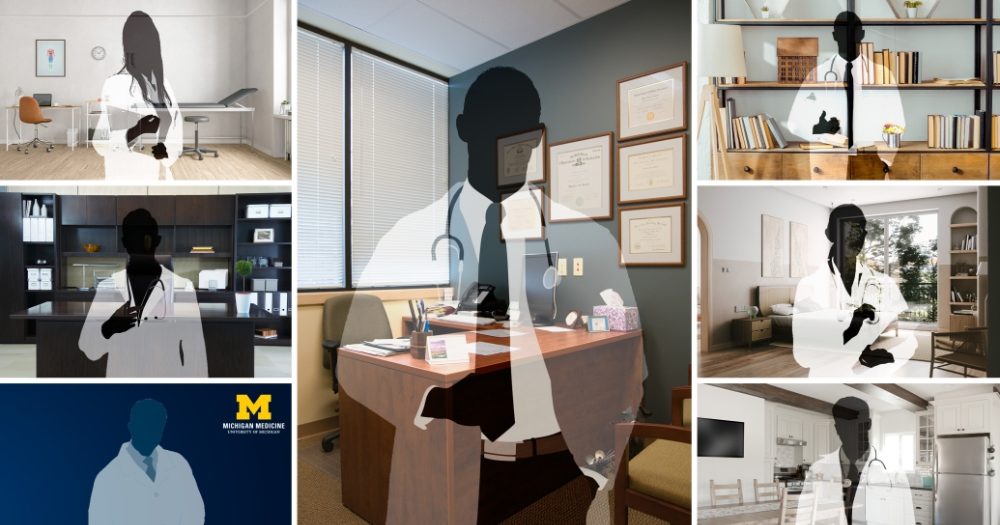Study: Background matters in telehealth sessions

In recent years, people around the world have increasingly relied on telehealth video visits with their doctors and other healthcare providers. A new study has uncovered that the background behind a doctor during these virtual consultations can significantly influence how patients perceive their care.
The study
The study, conducted by researchers from the University of Michigan's Michigan Medicine and the VA Ann Arbor Healthcare System, suggests that doctors should strive to create the illusion of being in a professional setting, even if they are miles away from their usual clinics. Ideally, doctors should conduct telehealth visits from an office with their diplomas prominently displayed behind them or use a virtual background that mimics such an environment. This setup is particularly important for first-time appointments, as it helps build initial trust and rapport with the patient.
Other acceptable backgrounds include a home office with a bookshelf or a plain, solid-color background. However, if the telehealth visit is conducted in a more personal space, such as a kitchen or bedroom, it is advisable to use blurred or virtual backgrounds to maintain a professional appearance. This approach ensures that the focus remains on the consultation rather than the provider's home environment.
Why does it matter?
The study's findings are based on a survey of over 1,200 patients who were asked to react to seven different backgrounds behind a model physician. They rated how knowledgeable, trustworthy, caring, approachable, and professional the physician appeared in each setting, as well as how comfortable they felt with the provider. The results revealed a clear preference for traditional office settings with diplomas and professional decor, which were rated the highest. In contrast, kitchen and bedroom backgrounds received the lowest scores, highlighting the importance of a professional appearance in virtual consultations.
Lead researcher Nathan Houchens, M.D., an associate professor of internal medicine at U-M, notes, "The transition to virtual care was rapid and came without specific guidance during the start of the COVID-19 pandemic, but telehealth appears to be here to stay. It's important to understand what patients prefer when it comes to the setting their provider is in."
This insight underscores the need for healthcare providers to pay attention to the details of their virtual environment to enhance patient comfort and trust.
The context
During the first year of the COVID-19 pandemic, healthcare providers were encouraged to conduct telehealth visits from outside of clinics to reduce the risk of transmission. Since then, telehealth has become a standard mode of receiving care, prompting some clinics to create dedicated spaces for providers to use for virtual appointments. These spaces, often shared with other clinicians, may also benefit from virtual backgrounds to minimize visual distractions.
As telehealth has increased in use, some guidance on "webside manner" has emerged to help providers interact effectively over virtual connections. However, there has been limited guidance on the visual elements of telehealth settings. The study led by Houchens and his team aims to fill this gap, providing valuable insights into patient preferences for telehealth environments.
Houchens and his colleagues, including co-author Sanjay Saint, M.D., M.P.H., have previously published work on patients' preferences for physicians' attire during clinical encounters. They found that seemingly superficial factors, such as attire and workspace appearance, can significantly impact the patient experience.
"Patients have expectations of what physicians' attire and workspaces should look like," Houchens explains. "Diplomas and credentials remind patients of the expertise they expect a physician to have, and conversely, something is lost when the background conveys a relaxed, informal home environment."
What's next?
The team is currently analyzing more data from the same study to assess other factors that affect patients' telehealth experiences, including their access to high-speed internet and their ability to use necessary technologies. For now, they suggest that providers take immediate steps to conduct virtual visits from an office or exam room, and clinics may want to make unused clinical rooms available for telehealth appointments. Alternatively, creating virtual backgrounds that evoke professional settings can also be effective.
Houchens also notes that while they haven't yet studied what physicians think of the backgrounds behind patients during video visits, these could provide helpful information. Discussing visible elements from both a provider's and a patient's virtual background — such as art and other hobby-related items — can help build rapport and enhance the patient-provider relationship.
"This study is a reminder that patients often care about some of the details that providers and health systems may not have emphasized," Houchens says. "It's important to remember that our words and our nonverbal behaviors are taken to heart by those we care for, and it behooves us to care about them as well." This underscores the broader impact of non-verbal communication and environmental factors on patient satisfaction and trust in the age of telehealth.
In addition to Houchens, Meddings, and Saint, the study's authors include Latoya Kuhn, MPH, David Ratz, MS, and Jason M. Engle, MPH, from the VA Center for Clinical Management Research and the U-M Institute for Healthcare Policy and Innovation. Their work continues to explore the evolving dynamics of telehealth to ensure that virtual care remains effective, professional, and patient-centered.
💡Did you know?
You can take your DHArab experience to the next level with our Premium Membership.👉 Click here to learn more
🛠️Featured tool
 Easy-Peasy
Easy-Peasy
An all-in-one AI tool offering the ability to build no-code AI Bots, create articles & social media posts, convert text into natural speech in 40+ languages, create and edit images, generate videos, and more.
👉 Click here to learn more


